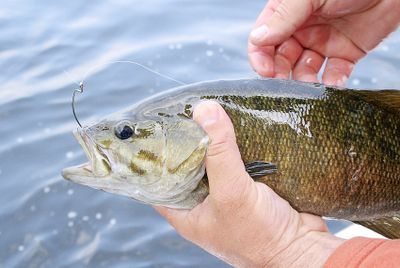Smallmouth bass boom bad for salmon

Like all trophy-hunting sportsmen, smallmouth bass anglers want to keep the big ones.
Fishery managers are trying to convince them to keep the smaller ones.
So much so, in fact, they’re considering paying them for it — for the very reason, and possibly, in much the same way, that for the past decade they have paid anglers a bounty to catch and keep northern pikeminnows.
Like the pikeminnow, the smallmouth bass feast upon enough chinook salmon smolts to affect salmon runs.
“(A bounty program) works for the pikeminnow. The studies say that’s helping,” said Anthony Fritts, an Ellensburg-based state fisheries biologist who has researched salmonid predation in the Yakima River by smallmouth bass.
The pikeminnow bounty, though, targets the larger pikeminnows, since they’re the ones feeding on salmon smolts. Any smallmouth bass program would almost certainly target the younger, smaller ones that do the most damage to the smolt population.
But neither Fritts nor state Fish and Wildlife Department regional fish program manager John Easterbrooks thinks a bounty program is the way to go.
“My unofficial opinion?” Fritts said. “I don’t know if it would really work. There’s too many bass.”
Easterbrooks said many fisheries biologists would rather see a removal of all bag limits on bass than the institution of a bounty.
“I can understand that (interest in removing all bag limits), but it really isn’t probably effective as far as reducing predation on salmonids,” he said. “Even if you took off all the regulations and just had open season on bass, barring a bounty, fishermen aren’t going to catch and keep enough bass to really put a dent in the population.”
Easterbrooks noted that the Yakima River regulations on bass fishing were “the most liberal bass regs in the state,” and yet the Lower Yakima is still a bass-fishing hotbed because there’s just so many bass.
Nonetheless, the concept of a smallmouth bass bounty is still “a front-burner item,” though not necessarily a likely option, said David Ward, anadramous fish management coordinator for the Columbia Basin Fish and Wildlife Authority.
Ward chaired a multi-agency workshop last September focusing on ways to enhance juvenile salmonid survival and came away unconvinced about targeting smallmouth bass.
“Unlike pikeminnow, a program like that for smallmouth bass or walleye is not likely to work, because the biology of the fish and their behavior don’t lend themselves to it,” he said.
A more likely answer, he said, would be finding ways to enhance the lamprey population in the mid-Columbia and tributaries, since lamprey would be a natural food source for the same predators that target salmonids.
Another possibility would be finding a way to limit shad.
“The predators eat the shad in the fall, and that makes them stronger and helps them survive through the winter,” Ward said. “If you exclude shad in the fall, fewer of those predators will make it through the winter.”
But, of course, finding a way to limit the shad could be expensive — not to mention disappointing to the anglers who enjoy catching the plentiful, though not-much-good-for-eating fish.
Finding a way to get more lamprey upriver could mean having to round off fish ladders at the dams, since the wall-sucking lamprey can’t easily get around corners — and that could be even more expensive.
Paying anglers to catch and keep smallmouth bass would be expensive, too.
The pikeminnow program, which has an annual budget averaging about $3 million, is estimated to have cut predation on salmon smolts by upwards of 25 percent.
But should NOAA Fisheries strategists put a bounty on bass? Easterbrooks doesn’t think so.
“They’re grasping at straws. They’re looking at anything they can do to improve salmonid success,” he said. “It’s kind of like, if you’re willing to shoot sea lions, hey, why not whack some bass? They’re going after predators, scapegoating the predators.
“The lower part of the Yakima River is paved with channel catfish. Hey, they’re a predator fish as well — want to put a bounty on them, too? There’s only so much you can do.”
Putting a bounty on the biggest smallmouth bass — a fish that generates high-profile fishing tournaments with television coverage and big-money purses — would be a public-relations nightmare, Easterbrooks said.
But going after the smaller ones? Maybe not, said James Castillo of Grandview, a tournament bass fisherman.
“If they were to make it a blanket policy, going after all bass, I’d go out of my way to oppose it. It would get a horrible response from me and all my peers,” Castillo said. “But if they were to make it (for bass) 12 inches or under, I’d support it.
“It would actually help the bass population on the Yakima River. Right now, there’s so many small ones that it’s stunting the growth; there’s not enough food for them. It might actually help the fishery.”